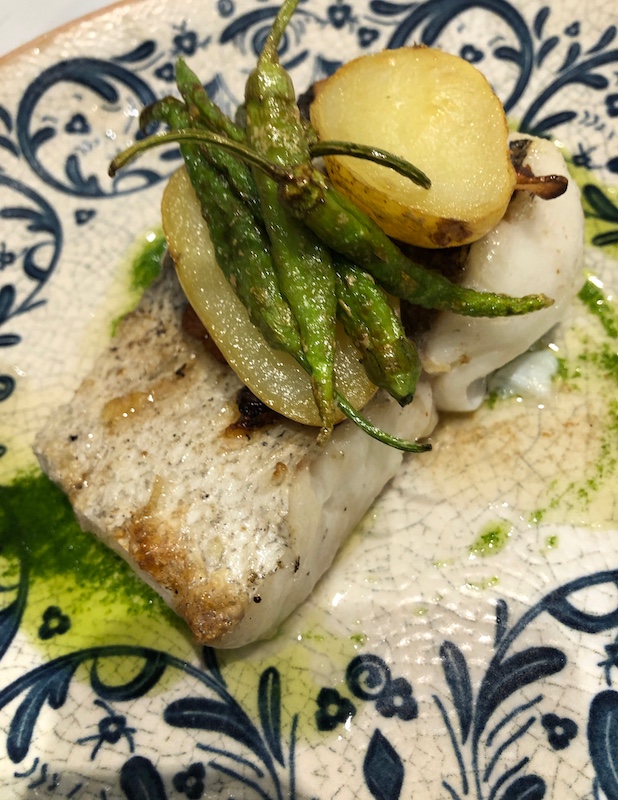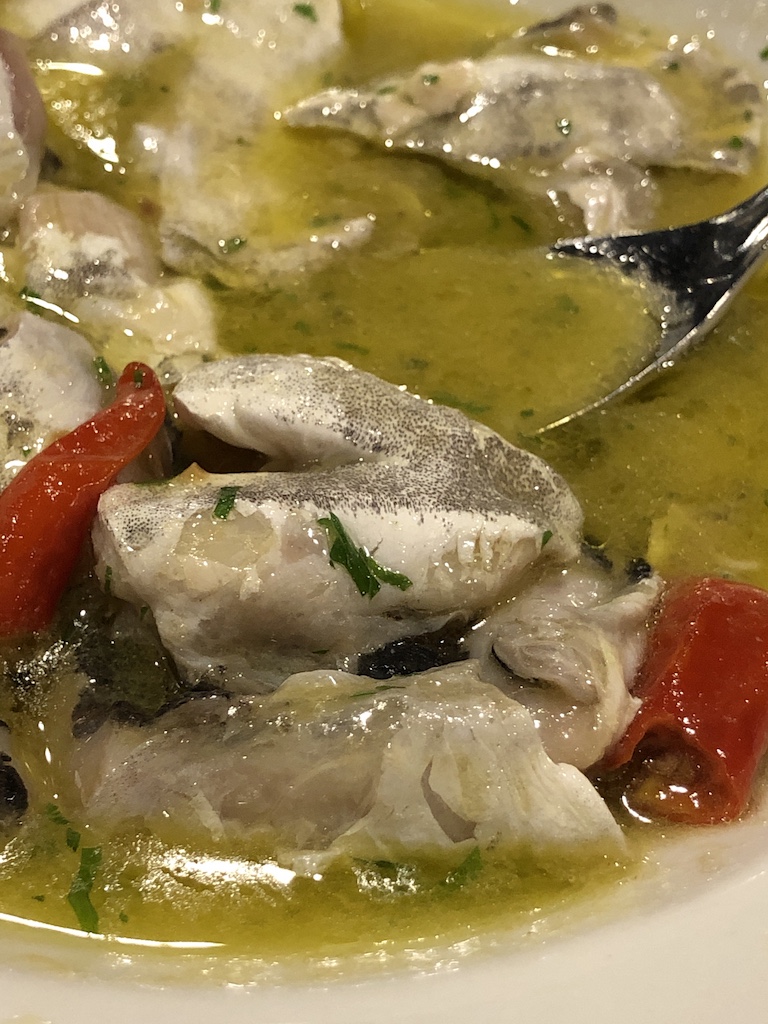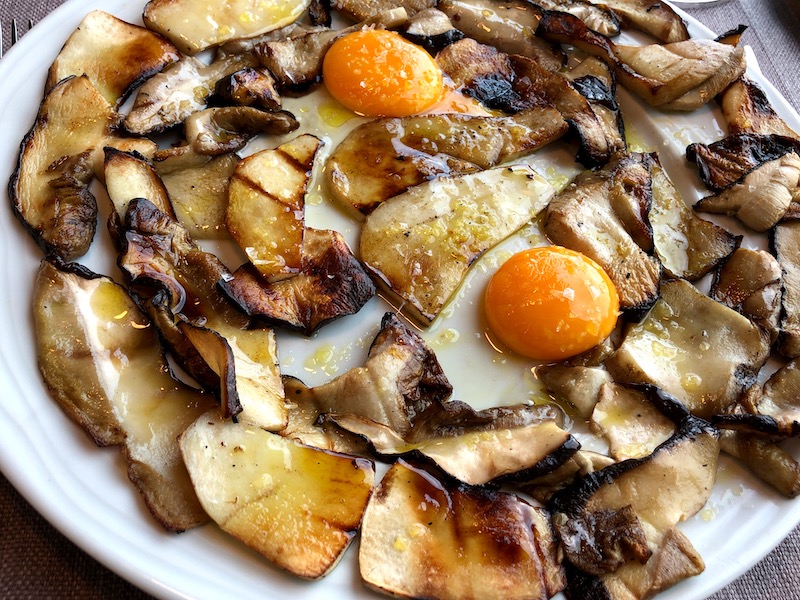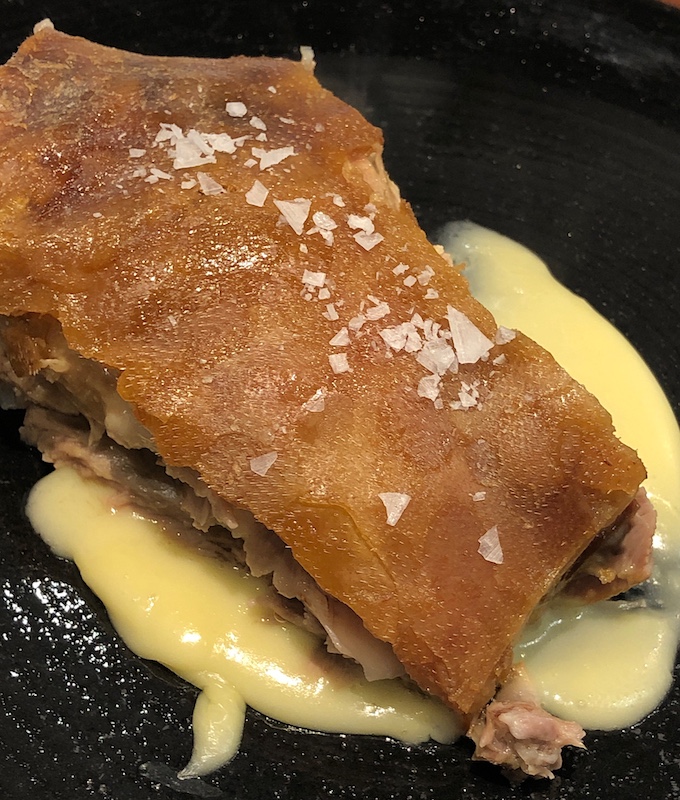During multiple trips to Spanish Basque Country during the past seven years, I’ve eaten at a couple of the region’s legendary Michelin-starred restaurants. The prices were obscene, the service was apathetic and those meals did nothing to educate my palate.
Then, in preparation for a repeat stay in my favorite fishing village, I asked an Airbnb host where the Basques go for special occasions. My goal was to identify establishments with great food and local color that were either a terrific value or a worthy splurge.
Her response, based on queries to family and friends, started me on a culinary adventure. In the course of a three-week stay last year in Getaria, my husband, Ken, and I ate in six of the places on her list. Back in the same location this year, but with less time to spend, we returned to our three favorites.
Together, their menus offer the opportunity to sample expertly prepared regional and seasonal cuisine and have a gracious dining experience. Though best visited by car, all are proximate enough to San Sebastián that they can be reached by taxi or public transportation. Here’s where we ate and suggestions about what to order. (Reservations are recommended. Phone numbers, including the country code, are below.)
Telephone: +34 943 860 551
We sometimes joke that the more secluded a Basque restaurant, the better the food. That would certainly be true of Bedua, which includes a small map on the back of its business card. Situated in an old stone house near Zumaia, on the banks of the Urola river, it looks out on a tiny island that contains the restaurant’s vegetable gardens. On a recent visit, we parked near the onions, and traversed neatly planted rows of lettuce, tomatoes, peppers and beans before crossing the footbridge to the dining room.
With a menu that changes as the seasons do, Bedua is a terrific place to sample iconic regional dishes. And the ideal time to do this is at lunch on a Friday, Saturday or Sunday, when several generations of Basques gather at banquet tables for a multi-course feast. Except for dessert, everything is served family-style, and the meal, which rarely starts before 2:00, could take several hours to complete. The celebratory mood is contagious.
In four visits there, we have skipped the cured ham that the groups generally order first, preferring items that require some cooking skill. When peppers are in season, Bedua (and many other eateries) offer them fried and sprinkled with salt to accompany aperitifs.
Eggs, prepared various ways, figure prominently as appetizers in Basque cuisine. Unfortunately, these belly fillers leave me little appetite for another course. But it’s worth a stretch (or perhaps a breach of protocol) to taste Bedua’s cod omelet (tortilla de bacalao). Delicate and fluffy, it bears no resemblance to the dried-out versions served elsewhere as tapas (or pintxos in Basque parlance). We once ordered it as a main course, preceded by the home-cured tuna, which is better than any bottled or canned version I’ve tasted.
And then there are the appetizers served with an oven-poached egg yolk on top. A recent example – and a seasonal treat – was Bedua’s homegrown flat green beans (called vainas), on a bed of mashed potatoes, the egg atop it garnished with shaved truffles. It was a splurge at €22 (the euro is worth just slightly less than the dollar right now), and not something we saw the banquet tables ordering.
Instead, they seem to put their money into items from the outdoor grill, or parrilla. These giant metal contraptions, fueled with wood charcoal, are distinctive because they permit the asador (grill master) to easily raise, lower and tilt the grate to control the distance from the flame of whatever he is cooking.
Typically, that’s fish or beef, and it’s not unusual to see them served in sequence at the banquet tables. Fish are cooked whole in a metal cage, and fileted at the table by the server. If you want what’s freshest, ask which are locally caught. Turbot, (rodaballo), for example, often isn’t. Other offerings include very delicate and precious sea bream (besugo), sole (lenguado) and monkfish (rape) – a firm, relatively tasteless fish that gains flavor from grilling.
Prices for both grilled fish and the premium T-bone steak (chuletón) are by the kilo, and can cost three or four times what you would pay if you bought them at the market and prepared them yourself. That can lead to sticker shock when the bill comes. For example, sea bream and sole, the most precious of the fish, fetch €95 per kilo, with a typical serving for two weighing about 1.5 kilos. At those rates, the fish course alone can easily run more than $100.
To try a less extravagant Basque specialty, one can order cocochas – gelatinous bits taken from the throat of a hake (€33). Bedua offers them grilled, breaded or in a green sauce. A classic in this region, the latter is an emulsion made with onion, parsley, garlic and olive oil, plus some cooking liquid from the fish. Those who find cocochas unappealing can order green sauce with hake (merluza) or cod (bacalao) instead.
Though green sauce is commonly found on the menus of other restaurants, a house specialty called pimientos del piquillo al pil-pil is not. Generally, the term pil-pil (pronounced peel-peel) refers to a manner of preparing fish. Some say this onomatopoetic term comes from the sound of vigorously rotating the ceramic cooking vessel until the oil, drizzled in a little at a time, emulsifies with the gelatinous liquid given off by the fish as it cooks.
In a vegetarian send-up, Bedua features the region’s much-prized beak-shaped red peppers, called piquillos, which are a key ingredient in everything from paella to meat or chicken stews. Bedua prepares the piquillos in an unusual way, slow-cooking them in the oven with a splash of cognac, salt and a pinch of sugar, until they caramelize and their own liquor emulsifies with the other ingredients. These sweet red peppers, already soft and smoky from the process of removing their skins, grow even more tender as they stew. Consumed as a starter on top of bread or as an accompaniment to a grilled steak, they dissolve on the tongue in an explosion of flavors.

Following the instructions of our server, I tried twice to replicate them in our Airbnb kitchen. Since fresh peppers were not yet available, I used canned ones from Lodosa, as she told me the restaurant does. The first time I forgot her instruction to cover the casserole until about halfway through the 90-minute cooking process.
On the second attempt, I guesstimated that my pil-pil peppers needed a bit more sugar, salt and cognac, and covered them from the get-go. Both batches were delicious, convincing me that this no-recipe recipe was almost impossible to ruin. But I’d go back to Bedua just to eat theirs, which were even better.
A lively conversation and long pause between courses might help make room for dessert. If so, Bedua’s raspberry cheesecake with cheese ice cream is a rich, dense version of a Basque favorite. Both that and the chocolate truffle cake with apple ice cream are large enough to share. But be forewarned: If by this time any doubt remains, dividing a dessert in Basque Country will immediately brand you as a tourist.
HOW TO GET THERE. From the main traffic circle in Zumaia, head toward Oikia. About one mile later, you will pass a sign for the restaurant, indicating that you should make a U-turn. Soon after, in an industrial zone, you will see a place to do that at a cambio de sentido. Once you have made the turn, head downhill, along a stone wall that leads you into the Bedua parking lot.
Telephone: +34 943 580 166
I’ve celebrated the past two birthdays at this winery-operated restaurant, perched high in the hills above the fishing village of Orio. Both times it rained, but that just made the mist rising over the mountains look even more dramatic. Nor did it interfere with the tractors shuttling back and forth, unloading grapes just harvested from nearby vineyards.
Katxiña is known for its Txakolina Getaria – a dry young white wine, with an AOC designation, produced by more than 30 local vintners. It’s widely available, for about $7 a bottle, at local butchers, specialty stores and supermarkets. But it’s even better if you have it with your meal there. At €2 per glass, it costs less than a bottle of Coca-Cola.
In the course of it, one gets the feeling of being surrounded by other diners who are celebrating something large or small. Maybe it’s the setting; this place is just made for special occasions. For a table with a view, it’s best to reserve far in advance and request a window seat. Otherwise, you could wind up next to the wine tanks, which is more like being in a company cafeteria. At least until the food arrives.
I could make a meal of Katxiña’s appetizers. Their hongos – thinly sliced wild mushrooms – cooked on the grill and seasoned with garlic, are meant to be served family-style. In that case, the first step is to toss them with the two oven-poached egg yolks that come on top. But one bite of this woody-tasting delicacy, and you might regret that you’ve agreed to share.

A standout on our most recent visit were the chipirones, or small squid. Grilled and served alongside their tentacles, these were smoky and tender, garnished with two classic Basque sauces that every visitor to this region ought to sample. One was green sauce. The other, made with the intense black ink of the squid, tends to be an acquired taste, but is easy to like in such a small quantity. Between these flourishes and the scattering of squid roe, which burst with flavor as you consume them, I struggled to organize all the sensations in each forkful.
As at Bedua, many of the main courses involve fish, but on our most recent visit we ordered the grilled T-bone steak. (Here, too, charges for both are by the kilo, with portions for two.) The Basques, who are expert ranchers, produce fabulous meats – so fabulous that they think they ought to be served nearly raw.
If you disagree, they will not be offended if you ask for it un poquito más hecho (a little bit better done). Delivered to our table sliced and sprinkled with salt flakes, it was the most flavorful and tender steak we have eaten anywhere. Surprisingly, the French fries, which we ordered to accompany it, were tasteless and seemed to be frozen.
My birthday would not have been complete without an order of Katxiña’s cheesecake, served with lingonberries and a scoop of raspberry ice cream. Though beautifully presented, it was a bit too fluffy for my taste. But having sampled Basque cheesecakes at almost every opportunity, I confess that I have yet to eat one that I really didn’t like.
Telephone: +34 943 683 078
When torrential rain delayed our arrival, it wasn’t really necessary to give the folks at this family-owned restaurant a heads-up; lunch reservations there guarantee you a table for the entire afternoon. But knowing that seating is limited, and having requested a quiet corner, we thought we owed them the courtesy. And they seemed to show their appreciation with an especially warm welcome. Since Covid, we learned, they have been closed for dinner, so no-shows are a liability.
Iriarte is known for its suckling pig (cochinillo), with perfectly crisped skin sprinkled with salt flakes, and juicy meat that falls off the bone. Unfortunately, it wasn’t included in the fixed price weekday menu the day we were there. But we saw plenty of pensioners taking advantage of that great deal: €21 for three courses and a glass of vintage wine, or a bottle of a less precious one for two to share. For most of the menu items we wanted, we needed to order à la carte.
A complimentary cup of hot carrot soup and a homemade sausage warmed our insides while we waited for the food to arrive. (What the French call an amuse-bouche is known as an aperitivo in Spain.) That, plus the suckling pig, would have been enough. But I had spotted txangurro a la donostiarra on the menu, and rarely pass up an opportunity to order it.
Think of this labor-intensive dish as a restuffed crab, prepared from the region’s much prized and aptly named spider crab that one sees in Basque fish markets. The cooked crabmeat is mixed with a rich sauce redolent of brandy or cognac, plus sherry, then returned to the top shell and warmed under a broiler.
Iriarte’s version had fewer crab chunks and more filler – diced vegetables, herbs and breadcrumbs – than others I have eaten. But it still warranted an approving “muy rico,” when the server asked how I had liked it. In Spain that is the most enthusiastic way of saying that something is delicious or filling or both.

For a starter, Ken had ordered marmitako – the Basque stew traditionally made right on the fishing boats after a tuna catch. Thickened with potatoes and flavored with several kinds of peppers, Iriarte’s send-up was hearty and the portion generous. Fortunately, the waitress had suggested that he order his main course, which was hake, grilled, rather than in a heavy sauce.
Thus satiated, we didn’t order dessert, but managed to make room for the bowl of chocolate-coated almonds served as a surprise with my espresso.
It was 4:30 by the time we left the restaurant. At several other tables, diners, who had already been there when we arrived two hours earlier, lingered. Their banter needed no translation. Body language clearly conveyed that they were savoring the moment.
Deborah L. Jacobs, a lawyer and journalist, is the author of Four Seasons in a Day: Travel, Transitions and Letting Go of the Place We Call Home and Estate Planning Smarts: A Practical, User-Friendly, Action-Oriented Guide. Follow her on Twitter at @djworking and join her on Facebook here. You can subscribe to future blog posts by using the sign-up box on her website’s homepage.
RELATED POSTS
A Croatian Island Hideaway Becomes a Gourmet Holiday
The Cabdrivers’ Guide to Singapore’s Best Hawker Food
 At Asador Bedua, several generations of Basques gather for multi-course weekend lunches. The celebratory mood is contagious.
At Asador Bedua, several generations of Basques gather for multi-course weekend lunches. The celebratory mood is contagious.







I love this story so much.
I’ve already shared it with my daughter Samantha, 28, who spent a good part of the summer in Barcelona and up the coast, her roommate/friend went up to San Sebastian as well.
I personally would savour hearing their voices and song, and observing their walk, posture and gestures.